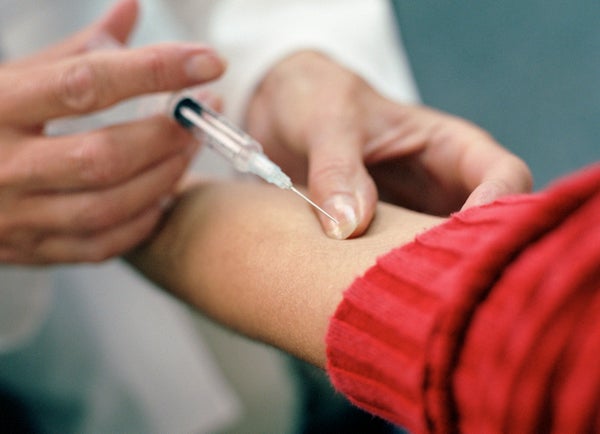Roughly a year after Brazilian doctors and researchers first suspected a link between a spate of alarming birth defects and the Zika virus, a cadre of potential vaccines are now headed for testing in humans. The flurry of action—at breakneck speed compared with most vaccine development—shows how a health emergency and a guaranteed global market can prod this process to move a lot faster than usual, with streamlined approvals and millions of dollars in government support.
The first candidate Zika vaccine is headed for the earliest stages of human trials in the next few weeks. By August a similar vaccine backed by the National Institutes of Health is expected to begin testing among human volunteers. And by winter several more vaccine candidates that employ various forms of the virus are slated for human testing, supported by funds from the NIH. “This is all good news,” says Anthony Fauci, director of the National Institute of Allergy and Infectious Diseases. “What we want is to have multiple candidates out there. Many vaccines go into phase I trials and never make it.” There is currently no Zika vaccine, so preventing mosquito bites and using condoms—the virus can also be spread by human sexual contact—remain the predominant ways to combat its spread.
The first vaccine to receive the green light for human trials is a product from Pennsylvania-based Inovio Pharmaceuticals. Unlike any other vaccine designed for human use, this product would be a DNA vaccine that only contains a particular part of the pathogen (rather than a vaccine with an inactivated live or dead virus, for example). This vaccine would include a circular plasmid of DNA with the genes of specific proteins of the Zika virus inserted into it, and its effect will be similar to that of an inactivated vaccine—making the virus unable to copy itself. This synthetic vaccine will hopefully trigger in recipients an antibody response that will help fight off any Zika virus it encounters.
On supporting science journalism
If you're enjoying this article, consider supporting our award-winning journalism by subscribing. By purchasing a subscription you are helping to ensure the future of impactful stories about the discoveries and ideas shaping our world today.
The catch is that DNA molecules are relatively large, making it difficult for such a vaccine to breach cellular membranes. To help it do so the vaccination would need to be administered along with very low-voltage electrical shocks—something that would have to be accepted by recipients and available in lower- and higher-resource communities alike.
Furthermore, there is no DNA vaccine currently licensed for use among humans. Yet there is reason for optimism: the NIH has already developed a DNA vaccine against the West Nile virus that appeared promising in early human studies (although ultimately the NIH could not find a commercial partner to take that vaccine forward).
In the coming weeks Inovio expects to test its vaccine on 40 human volunteers across three sites in North America. If it appears safe, Inovio plans to test its efficacy in field trials among Zika-affected populations in the Caribbean later this year, says Inovio CEO Joseph Kim.
Meanwhile the NIH’s product—also a DNA virus—will soon be tested among 80 human volunteers in Bethesda, Md. The product is “quite similar” to Inovio’s, Fauci says. Yet small differences could make one successful whereas the other might fail or be less effective. “You really can’t know what will have more immunogenicity until they get into trials, and that’s why we are testing them,” Fauci adds. If the NIH inoculation proves safe, it will then move to the next stage of trials in the Caribbean and South America—if the months-old budget request for emergency Zika funding clears Congress, he says.
But in the coming months other candidate vaccines will also be jockeying for attention. One product will employ a killed version of the Zika virus to spark an antibody response in its recipients. Another, developed by the Butantan Institute in Brazil, taps weakened forms of live Zika virus alongside dengue virus to make a vaccine against Zika, Fauci says. (The vaccine would take a dengue virus and genetically engineer it to include genes that encode for Zika proteins.)
In this early-stage testing, however, one big safety question will not be answered: If the vaccine may inadvertently trigger Guillain–Barré syndrome, a rare autoimmune ailment that can cause temporary paralysis (see related story). By some estimates one in 5,000 Zika patients develops GBS, but the question of whether the vaccine—which would contain some viral DNA if not the whole virus—will also cause this rare side effect will not be adequately answered in small trials that contain less than 100 volunteers. Instead, it will only become apparent in later-stage large trials.
Yet the timeline for such large trials remains murky at best. Even amid this fast-paced launch of early human tests, predicting exactly how long it would take to get an effective vaccine through large-scale trials, and to manufacture and deploy millions of doses remains a guessing game. “It really depends on the regulatory environment and cooperation as well as the urgency from the field,” Kim says.
